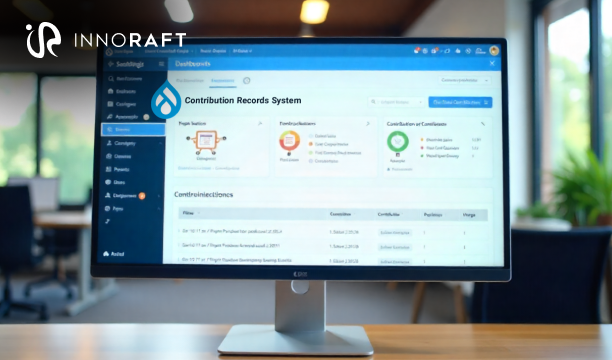What truly defines a modern, digitally transformed enterprise? It’s not just about adopting the latest tools or automating existing workflows. It’s about fundamentally reimagining how an organization operates, delivers value, and stays competitive in an ever-evolving digital landscape.
Digital transformation (DX) represents this comprehensive shift. It’s the integration of digital technology into every aspect of a business, operations, culture, customer experience, and innovation strategy. The goal is not only efficiency but resilience and responsiveness to change.
Open Source Software (OSS) plays a transformative role in this journey, especially when examining the growing impact of open source in digital transformation. By definition, OSS refers to software whose source code is publicly available for anyone to inspect, modify, and enhance. It promotes collaboration, transparency, and shared innovation, principles that closely align with the spirit of digital transformation itself.
Open source has evolved from being a niche choice for tech enthusiasts to becoming a strategic necessity for enterprises driving large-scale digital change. It empowers organizations to move faster, innovate more freely, and maintain control over their technology stack, all while staying cost-efficient and future-ready.
The Core Value Proposition of Open Source in Digital Transformation
Digital transformation isn't driven by technology alone. It is powered by the strategic value organizations can extract from it. Open source offers a distinctive edge here, transforming how enterprises manage costs, innovate quickly, and build resilient systems. These advantages form the core of open source's contributions to enterprise transformation and highlight the broader benefits of open source for enterprises.
A. Driving Cost Efficiency and Lowering the Cost of Ownership
One of the most tangible benefits of open source is its impact on cost. Traditional proprietary systems often require high licensing and subscription fees that escalate with scale. Open source eliminates those upfront costs, allowing organizations to start lean and invest more strategically.
Many enterprises begin with community versions of open-source software, gradually scaling to enterprise-supported offerings when stability, security, or SLAs are needed, a pattern common in open source adoption challenges. This flexibility ensures that budgets can be directed toward customization, integration, and innovation instead of being locked into vendor contracts.
Beyond the immediate savings, an enterprise open source strategy reduces long-term operational costs by minimizing vendor lock-in, giving teams the freedom to evolve their technology strategy as business needs grow.
B. Enhancing Flexibility and Agility
The enterprise digital transformation framework is never static. It demands continuous evolution. Open source's flexibility makes that possible. With full access to source code, enterprises can tailor solutions precisely to their unique workflows and strategic goals.
Unlike proprietary systems that dictate updates or product roadmaps, open source provides autonomy. Organizations can adapt their software at their own pace, integrate it seamlessly with other systems, and innovate without constraints.
The adaptability complements agile and DevOps methodologies, where rapid iteration, deployment, and feedback loops are essential. With the growing use of open source DevOps tools, organizations can accelerate delivery while maintaining flexibility. By removing dependency on external vendors, open source allows internal teams to own their innovation process end-to-end.
C. Achieving Security Through Transparency
Though it seems counterintuitive and unlikely, open source projects, such as community-driven Drupal support and maintenance, often provide better security. This is mainly due to its transparency and accessible codebase. The many eyes principle ensures that vulnerabilities are identified and resolved faster by global communities constantly reviewing and patching the code. Instead of relying on a single vendor's closed security model, open source projects benefit from a distributed network of contributors who detect flaws early and publish rapid solutions.
Moreover, the open nature of the code enhances trust and compliance, especially in industries handling sensitive data. Organizations can independently verify the integrity of their software, ensuring adherence to internal security and regulatory standards, a critical aspect of the role of open source in enterprise, as they strengthen governance and risk management.
However, the transparency offered by open source solutions is not a silver bullet. But the collective effort of a global community can generally identify and fix vulnerabilities much faster than a single proprietary vendor's closed-off team.
Key Areas of Open Source Impact on Enterprise IT
The influence of open source extends far beyond individual applications. It underpins the entire digital infrastructure that modern enterprises depend on. From open source web development to open source cloud infrastructure and data management, non-proprietary tools have reshaped the foundations of enterprise IT.
A. Open Source Impact on the Modern Cloud Infrastructure
Cloud computing is the foundation of the enterprise digital transformation framework, and it's mainly built on open-source technologies.
- Linux dominates as the operating system for cloud servers, powering most enterprise-grade infrastructure.
- Kubernetes (K8s) and Docker revolutionized how organizations deploy and manage containerized applications, enabling scalability and reliability in hybrid or multi-cloud environments.
- OpenStack provides enterprises with an open source alternative to building and managing private or public clouds.
These tools have not only reduced dependency on single vendor solutions but also standardized cloud orchestration and infrastructure management globally.
B. The Role of Open Source in Data Management and Analytics
As data becomes the lifeblood of digital business, open-source technologies are central to how organizations collect, process, and analyze it, especially with the rise of open source in AI and machine learning, powering modern data-driven innovation.
- Databases like PostgreSQL and MySQL are robust, scalable, and cost-effective options that rival their proprietary counterparts.
- Big data frameworks such as Apache Hadoop, Spark, and Kafka enable organizations to process massive datasets in real time, fueling data-driven decision-making and predictive insights.
The enterprise open source strategy has become the foundation for data-driven digital transformation, empowering enterprises to uncover patterns, optimize operations, and create more personalized customer experiences.
C. Open Source Accelerating Application Development and DevOps
The shift toward continuous integration and continuous delivery (CI/CD) has made open-source tools indispensable. Platforms like Jenkins, Git, and GitLab automate the software pipeline, allowing teams to build, test, and deploy code faster and with fewer errors; a clear demonstration of the power of open source DevOps tools in modern engineering workflows.
The open-source ecosystem also drives innovation in programming itself through languages like Python, Java (OpenJDK), and Node.js, and their vast libraries and frameworks. Developers can tap into these communities to build scalable, interoperable applications without reinventing the wheel.
This ecosystem nurtures collaboration and experimentation, which are essential qualities for sustained digital evolution.
D. Empowering AI and Machine Learning Initiatives
Artificial Intelligence (AI) and Machine Learning (ML) represent the next frontier of digital transformation, and open source is leading the charge.
Frameworks like TensorFlow, PyTorch, and scikit-learn have democratized access to advanced machine learning tools. This allows organizations to experiment, prototype, and deploy AI solutions without prohibitive costs, further highlighting the impact of open source in AI and machine learning on accelerating enterprise innovation.
By leveraging these open platforms, enterprises can integrate AI into existing business processes, automate decision-making, and drive innovation across customer engagement operations and analytics.
The collaborative open source AI ecosystem also ensures rapid evolution of algorithms and models, keeping enterprises at the cutting edge of innovation.
Navigating The Challenges of Open Source Adoption
While open source in digital transformation offers unmatched flexibility and innovative potential, it also introduces new operational, legal, and strategic complexities. Understanding these challenges is critical for enterprises to adopt open source responsibly and at scale.
A. Governance and Licensing Challenges
Adopting open source software for business transformation requires a structured approach to governance and compliance. Each open source component comes with its own license, GPL, MIT, Apache, or others, each with distinct permissions and restrictions.
To avoid legal or operational risks, many enterprises establish an open source program office (OSPO) to manage compliance, define policies, and oversee internal contributions to open source projects.
This framework ensures that open source is adopted responsibly, with apparent oversight on usage, modification, and redistribution.
B. Addressing Support and Maintenance Concerns
While an open source enterprise digital transformation framework provides flexibility, community support can vary in responsiveness or depth. Organizations often face the decision between relying on community-driven solutions or investing in enterprise-supported versions provided by vendors like Red Hat or SUSE.
The right balance depends on business criticality. Mission-critical workloads typically benefit from pain support and service-level agreements, while non-critical systems can thrive on community versions.
This hybrid approach optimizes both cost and reliability while maintaining the freedom that open source offers.
C. Special Skills Requirements
The role of open source in enterprises often demands in-house expertise to deploy, customize, and maintain systems effectively. Teams must understand both the technical and collaborative aspects of open source ecosystems.
Forward-looking organizations invest in training and upskilling developers, operations staff, and IT leaders to fully leverage these technologies. Encouraging employees to actively contribute to open-source communities not only builds skills but also raises the organization's visibility and influence.
D. Integration Challenges with Legacy System
Many enterprises still operate legacy systems that form the backbone of their business processes. Integrating open-source solutions into such environments can be challenging but achievable with the right strategy.
Adopting API-driven architectures, middleware, or containerization techniques can bridge compatibility gaps, enabling seamless coexistence between old and new technologies. Over time, this hybrid model supports gradual modernization without disrupting existing operations, a practical approach often emphasized in an enterprise digital transformation framework.
Strategic Recommendations for Enterprise Adoption
Enhancing open source effectively requires more than just adopting tools. It demands a shift in mindset, culture, and strategy- all foundations of a strong enterprise open source strategy. The following practices help organizations align open source adoption with business objectives while sustaining innovations and long-term value.
A. Adopt An "Open First" Mindset
An "open first" strategy encourages organizations to consider open source software for business transformation when evaluating technology options. This doesn't mean rejecting proprietary software entirely, but prioritizing open alternatives when they meet both business and technical needs.
This approach fosters innovation, interoperability, and long-term sustainability, allowing enterprises to evolve faster and adapt to changing market demands.
B. Contribute Back to The Open-Source Community
Open source thrives on collaboration. By contributing bug fixes, code, or documentation, enterprises strengthen the tools they rely on while gaining deeper insight into their inner workings.
Active participation also enhances reputation and influence within the community. Many leading organizations use contributions as a way to attract top developer talent and demonstrate leadership in technology innovation.
C. Create A Balanced Vendor Strategy
Partnering with the right vendors is crucial to overcoming open source adoption challenges. Enterprise should identify critical open-source components and work with vendors that offer reliable, professional support and security management.
This balanced strategy ensures access to expert assistance when needed, while maintaining the independence and flexibility of open-source adoption.
Conclusion: The Open Future of The Enterprise
Open source in digital transformation has redefined how enterprises pursue digital transformation. It delivers the speed, flexibility, and cost-effectiveness needed to keep pace with disruption and provides the foundation for sustainable innovation.
Organizations that harness the power of an enterprise open source strategy are not just consumers of technology; they become active participants in shaping it. By aligning open-source adoption with strategic goals, enterprises can continuously evolve and stay resilient in an increasingly digital world.
Key takeaways:
- Open source offers cost efficiency, flexibility, and faster innovation compared to proprietary software.
- It powers critical areas of enterprise IT, from cloud and data management to AI and DevOps.
- Successful adoption requires strong governance, skilled talent, and thoughtful integration with legacy systems.
- An Open-first mindset and active community participation strengthen both organizational capability and industry credibility.
- The future of digital transformation will be built not by isolated vendors, but by open collaborative ecosystems.
Want to know more about how you can leverage open source technology to power digital transformation for your enterprise? Connect with us today!
FAQ
Frequently Asked Questions
Didn’t find what you were looking for here?




